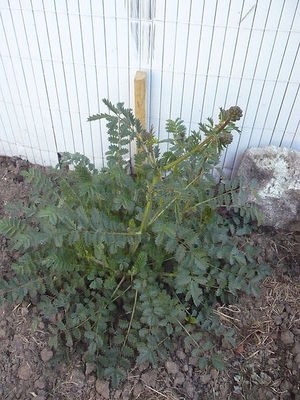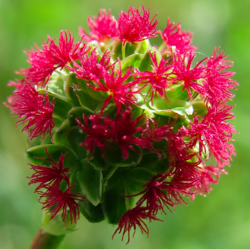Salad burnet (Sanguisorba minor) or (Poterium sanguisorba) is a perennial herb that has an appearance similar to a fern. If care is not taken to keep this herb in check (it seeds freely), it can escape the herb garden and become weed-like in other areas of the garden.[1] The salad burnet plant is frost, cold and drought tolerant, and is often found growing well in disturbed soils, such as along roadsides.[2]

Description[edit | edit source]
Salad burnet has leaves that are very fine, delicate, loose, and fern-like. The flowers are small and pink, purple-pink to reddish, with a roundish appearance.

The plant grows to about 25 to 32.5cm tall.
Although the leaves are fairly bland in colour, in bright light they can appear tinged with pink.
Growing salad burnet[edit | edit source]
Choose a location which has full sun.[1] It can tolerate light shade.[3] It is fine with average garden soil.[1] The soil should be well drained.[2] Either alkaline or slightly acidic soils will work for this plant.[2]
Choose between sowing seeds in the spring or dividing the plant in the autumn or fall.
Salad burnet will tolerate dry soil once established.[1]
Although the herb is perennial, it will benefit from being divided every three to four years, to encourage new growth and maintain its vigour.[1]
Harvesting[edit | edit source]
The leaves will last until winter, up until which time they can be picked and used as needed. However, only harvest the fresh new growth of leaves, as older leaves are tough and tend to be bitter.
To encourage more leafy growth, remove the flowers when they form.[1] This will also help you to keep the plant under control, as it can't seed unless the flowers are left in place.
Uses of salad burnet[edit | edit source]
Culinary[edit | edit source]
Salad burnet has a mild flavour of cucumber. This matches well with vegetable dishes, especially with celery and asparagus. Use as a fresh herb for best results. It is high in vitamin C when used fresh.[2]
At the beginning of winter, the fresh leaves can be added to stews, casseroles, soups and sauces, to add a refreshing flavour.
Salad burnet can be added to vinegars,[3] herb butters and cold drinks.[2]
Animal feed[edit | edit source]
The plant is useful for wildlife forage (big game, birds, and rabbits) and it is a good sheep forage, with high levels of protein and carotene.[2]
Restoration[edit | edit source]
Salad burnet has a role to play in erosion control after fires.[2] It can be used to grow in place of invasive or noxious weeds when repairing land after a fire.[2]